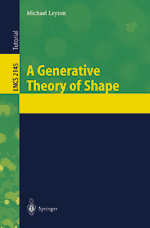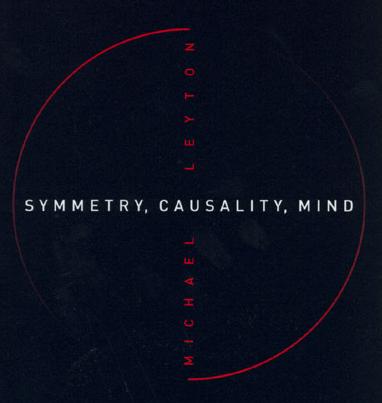September 15, 2005
BACK
Professor Michael Leyton,
Center for
Cognitive Science, Busch Campus, Rutgers
University, New Brunswick, NJ 08904, USA.
www.rci.rutgers.edu/~mleyton/homepage.htm
Center for Discrete Mathematics & Theoretical
Computer Science (DIMACS),
< mleyton@dimacs.rutgers.edu
>
Publications of Michael Leyton et al. :
Shape Representation:
- A Generative Theory of Shape,
2001.
- Group Theory and Architecture 1: Nested
Symmetries, 1999.
- Group Theory and Architecture 2: Why
Symmetry/Asymmetry ? 1999.
- Symmetry, Causality, Mind,
1992.
- Shape and Causal-History, 1992.
- Processes at Discontinuites, 1989.
- Inferring Causal History from Shape, 1989.
- A Process Grammar for Shape,
1988.
- 3-D Symmetry-Curvature Duality Theorems, 1987 &
1990.
- Symmetry-Curvature Duality,
1987.
- A Limitation Theorem for the Differential Prototypification
of Shape, 1987.
Perception :
- The Foundations of Aesthetics,
2006.
- Nested Structures of Control: An Intuitive View, 1987.
- A Theory of Information Structure II: A Theory of Perceptual
Organization, 1986.
- A Theory of Information Structure I: General Principles,
1986.
- Principles of Information Structure Common to Six Levels of
the Human Cognitive System, 1986.
- Generative Systems of Analyzers, 1985.
- Perceptual Organization as Nested Control, 1984.
BibTeX references.
The
Foundations of Aesthetics
Michael Leyton
Ch. 13 in Fishwick, P. (Ed), Aesthetic Computing, MIT Press, 2006
(expected).
Summary
A Rigorous Theory of Aesthetics
This
paper summarizes the theory of aesthetics that comes from the new
foundations for geometry developed in my books. The new geometric
foundations are based on two principles:
- maximizing transfer of structure,
- maximizing recoverability of the generative
operations.
According
to the foundations, these are the two basic principles of aesthetics.
This paper shows that the two principles are fundamental to
aesthetic judgment in (1) the arts, where we examine painting, music,
and poetry; (2) the sciences, where we examine general relativity and
quantum mechanics; and (3) computer programming, where we examine
object-oriented programming. It is shown that all these areas are
driven by the same two underlying principles: maximization of
transfer and recoverability. Transfer is formalized in terms of
particular products of groups. It is shown to be the basis of
Gestalt. Recoverability is shown to depend on a new theory of
symmetry-breaking, provided in the geometric theory. Together,
transfer and recoverability are shown to be the basis of memory
storage; and our rigorous theory of aesthetics says that the rules
of aesthetics are the rules of memory storage. In
particular, both the arts and the sciences are driven by the single
goal of maximizing memory storage. Finally, these principles are
applied to explain core phenomena in object-oriented programming.

Michael
Leyton
Springer-Verlag, Lecture
Notes in Computer Science, no. 2145,
554 pages, 2001.
"Geometry == Memory"
Summary
In this book, the author develops a generative theory of shape with
two properties fundamental to intelligence: maximizing transfer of
structure, and maximizing recoverability of generative operations. The
theory is applied in considerable detail to CAD, perception, and
robotics. A significant aspect of this book is the development of an
object-oriented theory of geometry. This includes a group-theoretic
formulation of object-oriented inheritance. In particular, a class of
groups is developed called "unfolding groups", which define any complex
shape as unfolded from a maximally collapsed version of itself called
an "alignment kernel". The group is decomposed into levels
corresponding to the inheritance hierarchy within the complex object.
This achieves one of the main goals of the theory - the conversion of
complexity into understandability. The advantages of the theory are
demonstrated with lengthy studies of robot manipulators, perceptual
organization, constructive solid geometry, assembly planning,
architectural CAD, and mechanical CAD/CAM
Keywords: Geometric Shape, Shape Theory, Geometric Objects,
Computer Vision, Robot Navigation, Visual Perception, Shape Generati-
on, Geometric Structure, Group Theory, Complex Shape, Wreath Products,
Erlanger Program, Geometric Invariants.
From "James Johnson" <James-Johnson@nyc.rr.com>:
- The purpose of the book is to develop a generative theory of
shape that has two properties regarded as fundamental to intelligence -
maximizing transfer of structure and maximizing recoverability of the
generative operations. These two properties are particularly important
in the representation of complex shape - which is the main concern of
the book. The primary goal of the theory is the conversion of
complexity into understandability. For this purpose, a mathematical
theory is presented of how understandability is created in a structure.
This is achieved by developing a group-theoretic approach to
formalizing transfer and recoverability. To handle complex shape, a new
class of groups is developed, called unfolding groups. These unfold
structure from a maximally collapsed version of that structure. A
principal aspect of the theory is that it develops a group-theoretic
formalization of major object-oriented concepts such as inheritance.
The result is an object-oriented theory of geometry.
The algebraic theory is applied in detail to CAD, perception, and
robotics. In CAD, lengthy chapters are presented on mechanical and
architectural design. For example, using the theory of unfolding
groups, the book works in detail through the main stages of mechanical
CAD/CAM: part-design, assembly and machining. And within part-design,
an extensive algebraic analysis is given of sketching, alignment,
dimensioning, resolution, editing, sweeping, feature-addition, and
intent-management. The equivalent analysis is also done for
architectural design. In perception, extensive theories are given for
grouping and the main Gestalt motion phenomena (induced motion,
separation of systems, the Johannson relative/absolute motion effects);
as well as orientation and form. In robotics, several levels of
analysis are developed for manipulator structure, using the author's
algebraic theory of object-oriented structure.
ToC
- Transfer
- Recoverability, p. 35
- Mathematical Theory of Transfer, I, p. 77
- Mathematical Theory of Transfer, II, p. 115
- Theory of Grouping, p. 135
- Robot Manipulators, p. 161
- Algebraic Theory of Inheritance, p. 175
- Reference Frames, p. 185
- Relative Motion, p. 213
- Surface Primitives, p. 229
- Unfolding Groups, I, p. 239
- Unfolding Groups, II, p. 257
- Unfolding Groups, III, p. 271
- Mechanical Design and Manufacturing, p. 299
- A Mathematical Theory of Architecture, p. 365
- Solid Structure, p. 397
- Wreath Formulation of Splines, p. 423
- Wreath Formulation of Sweep Representations, p. 443
- Process Grammar, p. 455
- Conservation Laws of Physics, p. 467
- Music, p. 477
- Against the Erlanger Program, p. 495
- Appendix A. Semi-direct Products, p. 531
- Appendix B. Symbols, p. 539
- References, p. 541
- Index, p. 549
Michael Leyton
Visual Mathematics, Volume 1, No. 3,
1999
web link
Introduction
In a forthcoming book, I give a comprehensive theory of design based
on group theory. Whereas the book itself requires an advanced knowledge
of group theory, the present series of articles will give the material
in an intuitive form, and build up any needed group theory, in tutorial
passages. The articles will begin by assuming that the reader has no
knowledge of group theory, and we will progressively add more and more
group theory in an easy form, until we finally are able to get to quite
difficult topics in tensor algebras, and give a group-theoretic
analysis of complex buildings such as those of Peter Eisenman, Zaha
Hadid, Frank Gehry, Coop Himmelblau, Rem Koolhaas, Daniel Libeskind,
Greg Lynn, and Bernard Tschumi. This first article is on a subject of
considerable psychological relevance: nested symmetries.
Michael Leyton
Visual Mathematics, Volume 1, No. 4,
1999
web
link

Michael Leyton,
MIT Press, 1992, 630 pp.
From Piero Scaruffi's Annotated
Bibliography of Mind-related Topics:
- "Leyton's idea is that shape is used by the mind to recover the
past. Shape is time. Shape equals the history that created it. By
studying the psychological relationship between shape and time, Leyton
offers a working model of how perception is converted into memory.
There is a relationship between perceived asymmetry, inferred history
and environmental energy. The energy of a system corresponds to memory
of the causal interactions that transferred to the system. Shape, or
asymmetry, is a memory of the energy transferred to an object in causal
interactions. All vision is the recovery of the past: vision simply
"unlocks" time from the image. In general, perceptual representations
are representations of stimuli in terms of causal histories. This is
also true of cognitive representations. Any cognitive representation is
the description of a stimulus as a state in a history that causally
explains the stimulus to the organism. A cognitive system is a system
that creates and manipulates causal explanations."
From the MIT Press:
- Michael Leyton's arguments about the nature of perception and
cognition are fascinating, exciting, and sure to be controversial. In
this investigation of the psychological relationship between shape and
time, Leyton argues compellingly that shape is used the the mind to
recover the past and as such it forms a basis for memory. He elaborates
a system of rules by which the conversion to memory takes place and
presents a number of detailed case studies--in perception, linguistics,
art, and even political subjugation--that support these rules.
Leyton observes that the mind assigns to any shape a causal history
explaining how the shape was formed. We cannot help but perceive a
deformed can as a dented can. Moreover, by reducing the study of shape
to the study of symmetry, he shows that symmetry is crucial to our
everyday cognitive processing. Symmetry is the means by which shape is
converted into memory.
Perception is usually regarded as the recovery of the spatial layout of
the environment. Leyton, however, shows that perception is
fundamentally the extraction of time from shape. In doing so, he is
able to reduce the several areas of computational vision purely to
symmetry principles. Examining grammar in linguistics, he argues that a
sentence is psychologically represented as a piece of causal history,
and archaeological relic disinterred by the listener so that the
sentence reveals the past. Again through a detailed analysis of art he
shows that what the viewer takes to be the experience of a painting is
in fact the extraction of time from the shapes of the painting.
Finally, he highlights crucial aspects of the mind's attempt to recover
time in examples of political subjugation.
ToC
- Recovering Process-History
Traces
Radical Computational Vision
Representation Is Explanation
Groups and Symmetry
Domain-Independent Rules
Linguistics
Art
Political Prisoners
M. Leyton
AI Journal, v.34(2), March 1988, pp. 213-247.
Web
link.
M. Leyton
CVGIP, v.38, pp. 327-341, 1987,
Summary
Establishes the "Symmetry-Curvature Duality Theorem":
- For a regular simply connected planar curve, to each extrema of
curvature there exist a symmetry axis which ends at that extrema.
Uses the SLS (smoothed local symmetries of Brady & Asada) as a
construction process (example) of symmetries.
Studies the Codon representation of Hoffman & Richards.
SLS-Codon Theorem:
- The SLS of a codon is unique and terminates at the point of
maximal curvature.
Details on evolutes: they bound (on each side) the loci
of maximally inscribed circles.
Note on information theory:
- The "creation of greater information by curvature is compensated
by the creation of greater redundancy" (and thus, paradoxically! lesser
information content, according to Shannon's theory) "of the associated
symmetry."
- See the discussion by Arnheim on Art and Entropy.
BACK
Page created & maintained by
Frederic Leymarie,
2000-5.
Comments, suggestions, etc., mail to: ffl at gold dot ac dot uk


